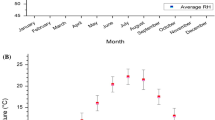Abstract
The Basilica of Santa Maria Maggiore, Rome, is an example of how ancient buildings with thick walls lessen the impact of the external temperature and humidity variations. The external influence on the internal microclimate is studied in order to gather information on how the building exchanges heat and moisture. Correlations between outdoor and indoor values are found. The results are applied to the calculation of the condensation-evaporation cycles inside micropores due to the Kelvin effect, to assess their impact on works of arts placed inside and outside the Basilica. It was found that the building attenuation is not sufficient to avoid damage due to condensation-evaporation cycles on stones and plasters. Some suggestions are made in order to mitigate the temperature variations during the liturgical offices.
Similar content being viewed by others
References
Camuffo, D.: 1984, 'Condensation-Evaporation Cycles in Pore and Capillary Systems According to the Kelvin Model', Water, Air and Soil Pollution 21, 151–159.
Camuffo, D.: 1998, Microclimate for Cultural Heritage, Elsevier, Amsterdam, 416 pp.
Camuffo D., Sturaro G., and Valentino A.: 1997, The Climate of Venice and its Action on Monument Decay, Proceedings of the 4th International Symposium on the Conservation of Monuments in the Mediterranean, Vol. 2, pp. 53–65.
Carslaw, H. S. and Jaeger, J. C.: 1953, Operational Methods in Applied Mathematics, Oxford University Press, Glasgow, 359 pp.
Huynh, C. K., Savolainen, H., Vu-Duc, T., Gullemin, M., and Iselin, F.: 1991, 'Impact of Thermal Proofing of a Church on its Indoor Air Quality: The Combustion of Candles and Incense as a Source of Pollution', Science of Total Environment 17, 1803–1809.
Kreith, F.: 1973, Principles of Heat Transfer, Dun — Dunnelley, New York, 651 pp.
Kusuda, T.: 1985, 'Heat Transfer in Buildings', in Rohsenow, W. M., Hartnett, J. P., and Ganic', E. N. (eds.), Handbook of Heat Transfer Applications, McGraw-Hill, New York, pp. 1–55.
Landsberg, H. E.: 1981, The Urban Climate, Academic Press, New York, 277 pp.
Mason, B. J.: 1971, The Physics of Clouds, Clarendon Press, Oxford, 671 pp.
Ryd, H.: 1970, 'The Importance of Meteorology in Building', in Building Climatology, Tech. note No. 109, WMO — No. 255.TP.142, World Meteorol. Organiz., Geneva, pp. 23–36.
Rohsenow, W. M., Hartnett, J. P., and Ganic', E. N.: 1985, Handbook of Heat Transfer Applications, McGraw-Hill, New York.
Thomson, W. (Lord Kelvin): 1870, 'On the Equilibrium of Vapour at a Curved Surface of Liquid', Proc. Roy, Soc. Edinburgh 7, 63–69.
Rights and permissions
About this article
Cite this article
Camuffo, D., Sturaro, G. & Valentino, A. Thermodynamic exchanges between the external boundary layer and the indoor microclimate at the Basilica of Santa Maria Maggiore, Rome, Italy: the problem of conservation of ancient works of art. Boundary-Layer Meteorology 92, 243–262 (1999). https://doi.org/10.1023/A:1002026711404
Issue Date:
DOI: https://doi.org/10.1023/A:1002026711404




